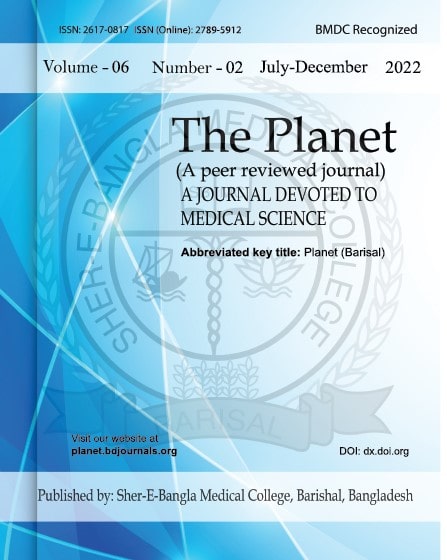Abstract
Introduction: Pterygiumis a degenerative , triangular wing shaped, fibro vascular connective tissue of bulbar conjunctiva towards and onto the cornea, leading to significant astigmatism . Pterygium is a common ophthalmic condition of tropical and sub-tropical country like Bangladesh where there is dry sunny hot dusty climate. Purpose: To find out the epidemiological trends such as age and gender distribution,effect of living conditions and occupation etc. on the occurrence of pterygium. Methods and Materials: This prospective study was carried out from March 2021 to December 2021 at Ophthalmolgy Department, Sher-E-Bangla Medical College & Hospital, Barishal.Total 68 patients with different grades of pterygium were studied and analyzed. All the eyes underwent detailed ocular examination like visual acuity measured by Snellen’s chart; refractive astigmatism measured by automated keratometry and slit lamp biomicroscopy.Results: Pterygium is more common in males (61.76%) than females (38.23%). 45.59% cases were in age group of 31-40 years followed by 33.82% in 41-50 years and rare (2.94%) in more than 60 years;so, 86.76% cases are in the age group of 31-60 years.Pterygium is more common in outdoor works 41(60.29%) to indoor workers 27 (39.71%). Location of pterygium is more on the nasal side 61 (89.70%) than temporal side 07 (10.30%). More common in rural population 42 (65.60%) compared to 22 (34.40%) in urban population. Most of the pterygium were from Grade -II to Grade –IV which is when combined about 92.65%. Conclusion: Pterygium is more common in middle age group, males, rural people and outdoor workers .Presentation is usually late with Grade II to Grade IV pterygium.UV-B exposure is the major risk factor for pterygium formation.

This work is licensed under a Creative Commons Attribution 4.0 International License.
Copyright (c) 2023 The Planet


 PDF
PDF